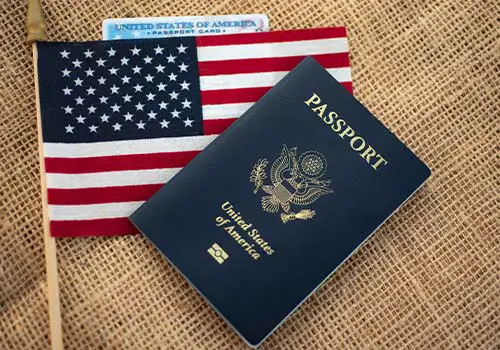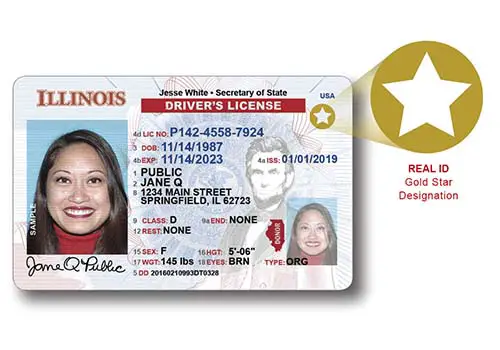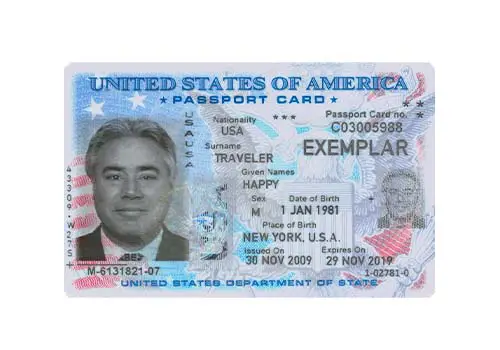Passport Card VS. Real ID | What’s The Difference? [Full Guide Inside]
Table of Contents

Most people know that you need to carry some form of identification when traveling. Whether you are boarding a domestic flight, leaving on a cruise, or simply driving to another country, the type of identification varies based on how you are traveling. The Real ID has gotten a lot of attention lately, but what is it? Is it a substitute for a U.S. passport card, and can you use the Real ID when flying internationally? We will tell you everything you need to know about a Real ID and highlight the key differences between the Real ID and a passport card.
What Is A Real ID?

In response to the terrorist attacks of September 11, 2001, Congress passed the Real ID Act. This Act set forth minimum security standards for driver’s license issuance and production. The Act also prohibits Federal facilities from accepting a driver’s license for certain purposes from a state that does not comply with the Act. This is to help ensure the safety and security of these facilities. The Department of Homeland Security (DHS) will enforce the provisions that are specified in the Act. In addition, a Real ID will soon be required to board domestic flights and enter most Federal buildings and military bases. The original deadline was October 1, 2020; however, that has been pushed to May 3, 2023, due to the Coronavirus pandemic.
A Real ID is a driver’s license or another state-issued identification card that meets these minimum security standards. To easily mark compliance, these cards have a star at the top. It is the responsibility of each state DMV to meet the requirements and issue licenses that are compliant with the Real ID Act. The physical license itself is not much different from a regular license. However, the process of obtaining the ID is much more involved. More documentation is required to obtain the ID, such as documents showing your full legal name, physical address, citizenship status, and other requirements. This process helps ensure that these IDs are not issued fraudulently or incorrectly.
What Is A Passport Card?

A passport card is an ID card that proves both your identity and citizenship status. Most people know that passports are required for international travel. However, you should know that a passport card is a little different than a traditional passport book. Passport cards are smaller — about the size of a credit card. They do not have blank pages for customs stamps when entering other countries. In fact, the passport card can only be used for a few limited situations.
First, the passport card cannot be used for international air travel. It can only be used when entering another country via land or sea. Next, it can only be used to enter a handful of countries. The only countries in which you can use a passport card are Canada, Mexico, Bermuda, and some Caribbean countries. A passport card is a great option if you frequently perform border crossings into Canada or Mexico or if you are heading on a Caribbean cruise. The passport card is cheaper and easier to carry than the passport book, and it can simply be scanned at the border as you cross into the other country.
Key Differences Between Real ID & Passport Card
Though a Real ID offers more security features than a standard driver’s license, there are still some key differences between it and a passport card. First, the Real ID-compliant driver’s license is issued by the state in which you live, thus making them a state ID. Passports, on the other hand, are issued by the Federal government — specifically the U.S. Department of State. A Real ID can only be used as proof of identity. It does not prove your status as a U.S. citizen. However, a passport card proves both your identity and U.S. citizenship status.
Another key difference between these two identity documents is where you are allowed to travel with them. A Real ID does not allow you to enter other countries. You will need a passport for that, and you can use the passport card when entering some countries via land or seaports of entry. The application process and cost of these documents are quite different as well. You will need to head down to your local DMV to obtain a Real ID; however, you need to submit an application to the U.S. Department of State for a passport card. It currently takes 8 to 11 weeks to receive your passport back in the mail.
Do not confuse a Real ID with an Enhanced Driver’s License (EDL). The enhanced driver’s license is only available in a few states, and it is similar to a passport. In fact, you can use it to prove both your identity and citizenship. Some countries even allow entry using an enhanced driver’s license. Though they are not Federally-issued, they can be used as a passport when entering Canada or Mexico.
How To Get A Real ID
So, if you have decided that the form of ID you need is the Real ID, how do you get one? You will need to check with your state’s DMV to verify specific requirements, as the requirements vary a little from state to state. However, there are some basic requirements that are the same. You will need to provide documentation of your full legal name, date of birth, Social Security number, proof of address of principal residency, and lawful status. Acceptable documents typically include a birth certificate, Social Security card, permanent resident card, mortgage statement, vehicle registration, and other items. These documents may also vary slightly from state to state, so make sure that you verify requirements in your area before heading down to the DMV.
Similarly, most states require an appointment to obtain a Real ID. You cannot simply drive down to the local motor vehicle office and expect to receive your Real ID that day. You must schedule your appointment ahead of time, and it can sometimes take weeks to even get an appointment. Once your documents are verified, then you just need to pay the proper fee to have your Real ID issued.
Passport Card Application Process
Now that you know how to get a Real ID let’s discuss the process for getting a passport card. The process for getting a passport card or a passport book is the same, but the card’s cost is a little less. First, you will need to complete a Form DS-11. This is the application for first-time applicants. In addition to the completed application, there is also some documentation that you will need to include with your application. You will need proof of identity, proof of citizenship, a current passport photo, and payment for the passport fee.
You may choose to mail your application to a passport processing facility; however, you should know that only original documents are accepted. Since most people do not want to mail their original birth certificate or driver’s license, they apply in person. This can be done at a participating post office or passport agency. You will need to make an appointment before arriving at the facility. Current processing times are 8 to 11 weeks, although you can pay a fee to have your application expedited. In that case, you can expect processing to take about 5 to 7 weeks.
One additional consideration when applying for your passport is your criminal record. Many people wonder, “Can a felon get a passport?” The answer is sometimes, but not always. If you have a felony conviction for drug charges, particularly for distributing drugs, then your passport is likely to get denied. Your application might also be denied if you owe child support that has not been paid.
When You Need A Passport Book
There are some occasions when a passport card or Real ID will not work for your needs. A passport book is crucial at certain times. Although you can use a Real ID to get through the Transportation Security Administration (TSA) screening for domestic air travel, it cannot be used for international air travel. To board an international flight, you must have a passport book. There is no other option when traveling to a foreign country by air. Similarly, you need a valid passport book to enter many countries. Remember that the only countries you can enter with a passport card are Canada, Mexico, Bermuda, and some countries in the Caribbean. If you are traveling to a country not listed here, then a passport book will be required.
The process for obtaining a passport book is the same as getting a passport card. Complete the application and submit it by mail or in-person along with the required documentation. Then you wait for your new passport to arrive in the mail. Adult passports will be valid for ten years, while a passport for a minor (under 16) will be valid for five years.
The Bottom Line
A Real ID is a state-issued driver’s license that includes additional security features. These features are required by the Federal government for access to certain Federal buildings and facilities. A passport card, however, allows you to perform international travel to some countries by land or sea. It is about the size of a driver’s license, but it proves both identity and citizenship.
Frequently Asked Questions
Do I need a Real ID if I have a passport card?
It depends on your future plans. Although a Real ID will soon be required for domestic flights, you may use a passport card for domestic flights instead. This would prevent the need for a Real ID in that case. However, if you need access to certain Federal facilities, then a Real ID will be required. A passport card may not be accepted at every facility. With the Real ID deadline approaching, it is a good idea to go ahead and get one so that you will be prepared for whatever situation arises.
What are the benefits of getting a passport card?
A passport card allows you to easily cross the border into Canada or Mexico. It is much easier to carry than a traditional passport book, and it is also cheaper. You can simply scan the passport card to make border crossing extremely easy. You can also use the passport card to visit Caribbean countries as part of a cruise.
What is the cost of a passport card?
For first-time applicants, a passport card will cost you $65. This includes a $30 application fee along with a $35 execution fee. When renewing your card, it will only cost you $30. There is no execution fee for renewals. If you are obtaining a passport card for someone under 16, then it will cost you $50. This includes a $15 application fee and a $35 execution fee. Since a child’s passport is not eligible for renewal, the price will be the same whether this is the child’s first passport or not.
